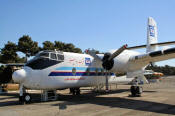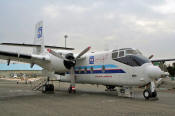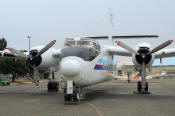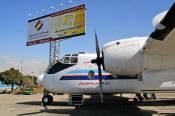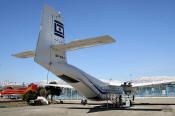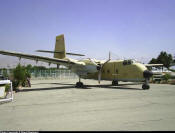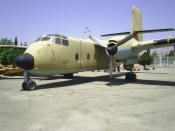|
|
Iran Air Force
| Peter Vercruijsse has reported this aircraft is cn # 52, ex Air America B-853, renumbered USAF 61-2388 in August, 1968 (aircraft continued to be used by Air America). Sold to Southern Sky Inc. on June 27, 1973 and used in support of Project Ibex. |
| Michael visited the Tehran Aerospace Museum in Iran in February, 2008 and photographed the resident DHC-4 in new colors with the registration of EP-RAJ . He believe it is a insurances company who sponsored the paint job. Yep.. it is winter in Tehran and that is snow on the Alborz mountains in the background. (Michael Prophet) Visit his great web site at: www.michaelprophet.com | ||||
Project IbexProject Ibex was launched in around 1974, with Iran and the USA as equal partners, however, Iran paid almost the entire cost of the project, some $500 million, to the main US contractor - Rockwell Inc. Project Ibex was a joint CIA+NSA / Iran enterprise for building and operating a series of observation and listening posts along the Soviet border, as well as for the purchase and operation of a number of reconnaissance aircraft. There were five ground stations; three jointly run by the IIAF/USAF crews and two operated by the CIA or, more likely, the NSA. The CIA-crewed stations were established at Bushehr (Tracksman 1) and at Kapkan (Tracksman 2). The most distinct functions of these five intelligence-gathering stations were: to monitor the radio and telemetry traffic of the Soviet armed forces in southern USSR, especially to find evidence of heightened military activity; to monitor Soviet missile testing; and to receive high resolution photographs from the orbiting spy satellites. USAF aircrews flying ELINT missions out of U.S. bases in such places as Okinawa and Alaska were alerted by Tracksmen messages to watch for Soviet missiles. These sites were considered so sophisticated that Stanfield Turner described them as systems built for the 21st century. Certain elements of the IIAF were also included in Project IBEX and were tasked with providing air defense for all five stations; all the stations were also surrounded by barbed-wired and mine fields and could be quickly blown up in the event of some unauthorized personnel managing to gain entry. Additionally, two DHC-4 Caribou STOL aircraft were purchased solely for the task of supplying logistics and transporting personnel to the remote IBEX stations. With this in mind it’s interesting that, although the IIAF never operated the DHC-4 Caribou, one is still on display at the IIAF Museum, in Mehrabad, Tehran - in full IIAF markings! The fate of the other Caribou is unknown. |
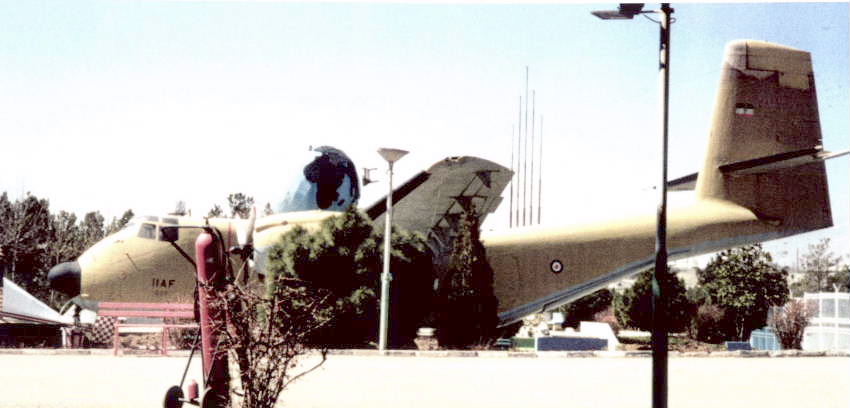
>>> Taken on 10-7-02 (Thomas Pohl)

| Graham
was able to find more about this aircraft:
11/18/00
I now
have some more information about the Caribou in Iran. I have spoken with
the person who gave me the photo, and he has confirmed
The aircraft was 're-discovered' by westerners (well, UK-based enthusiasts) during late 1996/early 1997 by somebody who works for British Airways (BA). He managed to visit the museum in Feb 1997, and had the opportunity to crawl all over most of the aircraft in the museum (there's a DHC-2 Beaver there too). For most of the aircraft he was able to get a positive identity for each aircraft, but the interior of the DHC-4 had been mostly trashed and he was unable to find a manufacturers plate. On the forward fuselage (in 1997) it was just marked 'IAF', but it was possible to see where the first 'I' had been scrubbed. The first 'I' was 'Imperial', but this was removed from all aircraft at the time of the revolution in the mid/late 70's. The number under the 'IAF' is either '552' or '553', but this is its Iranian identity, not necessarily its former US identity. At the time of the visit in 1997, the guy from BA spoke with the museum curator, and he was told that the aircraft used to fly up and down the Iran/Russian border full of 'electronics gear'. At the time of the revolution the gear was removed and the aircraft left in Iran - therefore it may well have been a USAF/US Army example! The curator also implied that the aircraft had been in the museum since the 80's. |
